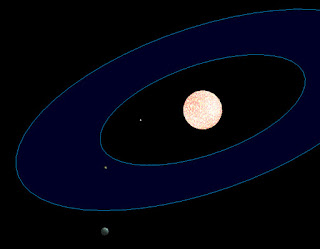 |
| The white dwarf G29-38 (NASA) |
This last question is particularly interesting because White Dwarfs are the remains of a Red Giants. Red Giants are the last phase of fusion based main sequence stars. Between White Dwarf, Red Giant and main sequence phases, a star changes so drastically that it is unlikely planets close to the star would survive into the next phase. Some very interesting things need to happen for a planet to form within the Habitable Zone of a White Dwarf.
With main sequence stars, the Habitable Zone slows moves away from the star because the star slowly gets hotter. A planet that starts out within the Habitable Zone of a young main sequence stars may not remain within the Habitable Zone for the full length of that star's life-cycle.[001] [002] Oddly enough, White Dwarfs have the exact opposite problem. White Dwarfs cool down as they age.[003] Habitable Zones around White Dwarfs will shrink until being too small for any sizable planet to exist within it.
The Habitable Zone around a White Dwarf is very small compared to that of Sun. The Habitable Zone around Sun is roughly between the orbits of Venus and Mars. The Habitable Zone around a White Dwarf is much closer than even the orbit of Mercury around Sun.[003] It seems a planet that close to a White Dwarf cannot exist without some special events.
How do planets get to the Habitable Zone?
A planet could have existed in the previous solar system during the main sequence star phase, but much further out; so far out that it may not have been previously habitable. When the main sequence star expands to become a Red Giant, then explodes to leave a White Dwarf, the planet would have to move from the outer reaches of the solar system to a stable close orbit. This sounds incredible, but apparently it is possible since planets have been discovered around Neutron Stars, which go thru even more violence.[003]Another possible scenario is it the matter ejected from the exploding Red Giant, or other remaining debris within the solar system somehow creates a new accretion disk around the newly formed White Dwarf, from which new planets could form.[003]
 |
| Water Cycle |
Even if either of these scenarios do happen, a water related challenge presents itself. A lot water must somehow remain or be (re)introduced on these special planets. Water is likely stripped from any existing planet that moves so close to the White Dwarf.[004] Water is also unlikely to be available on any planet that forms so close to any star, White Dwarf or otherwise. Maybe these planets could gather new water via the same processes as Earth, possibly "delivered to by a barrage of comets."[003]
If a planet is lucky enough to form around a White Dwarf, what's that White Dwarf going to look like in the sky? White Dwarfs have a lot of mass, but they are very small in size. White Dwarfs are about the same size as Earth.[005] By my rough calculations, the Habitable Zone around a White Dwarf is about 5 times the distance of Earth to the Moon. So, I image the White Dwarf would appear several times smaller in the sky as the Earth appears to the Moon. Maintaining habitability of planet around a White Dwarf might be a bit like trying to keep warm outside on a freezing night next to a slowly fading campfire.
Primary reference:
A Loeb, D Maoz, Monthly Notices of the Royal Astronomical Society: Letters, Volume 432, Issue 1, p.11-15, arXiv:1301.4994 [astro-ph.EP], Detecting bio-markers in habitable-zone earths transiting white dwarfs
Article Series:
- Limited lifespan of Habitable Zones around other stars [and a loosely held secret finally revealed about me]
- Small stars may have stable Habitable Zones, but habitable planets might not be common there
- Habitable Planets around White Dwarfs
- Habitable Worlds Around Binary Star Systems might not match Sci-fi
- How many Earth-like planets are orbiting Sun-like stars?
- First round of life in the Universe might have been possible extremely early
- Factors a planet needs for suitability of life; perhaps
- "Goldilocks zone of metallicity" on a galactic scale
- Maybe we are the first






